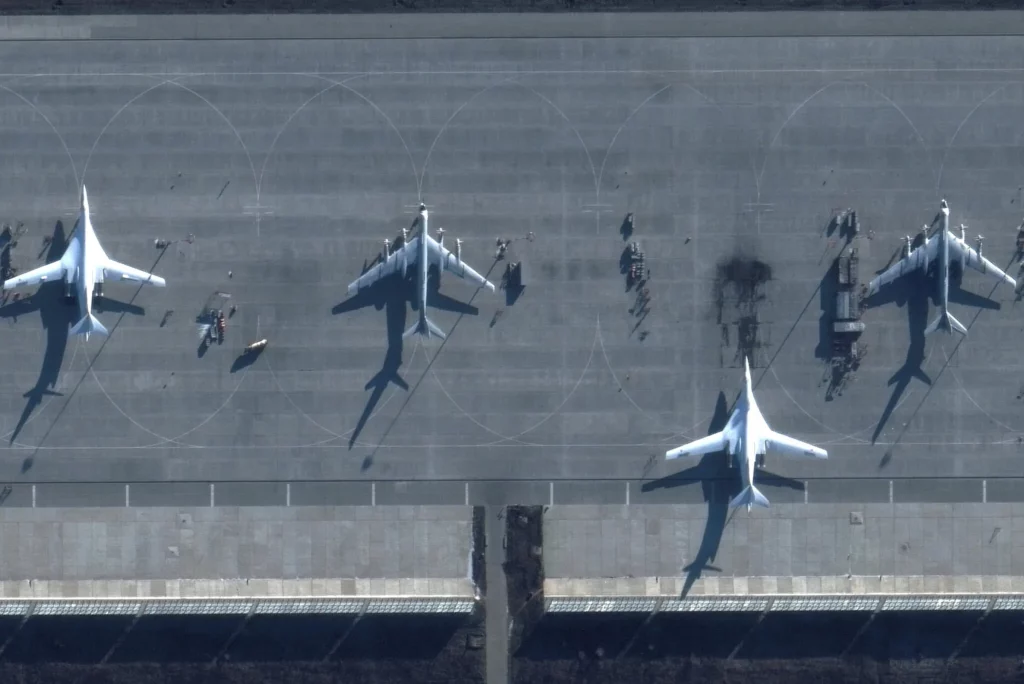Ukraine Striking Into Russia
A welcome development in a long and bloody war.

For months, Ukrainian leaders have asked for longer-range missiles, which US leaders have not provided, fearing escalation of the war with Russia. Yesterday, we learned that we’ve gone so far as to secretly modify HIMARS rocket launchers so they couldn’t fire at full range. It turns out, Ukrainian forces can strike Russian targets without those tools.
NYT (“Ukraine Targets Bases Deep in Russia, Showing Expanded Reach“):
Ukraine executed its most brazen attack into Russian territory in the nine-month-old war on Monday, targeting two military bases hundreds of miles inside the country using drones, according to the Russian defense ministry and a senior Ukrainian official.
The drones were launched from Ukrainian territory, and at least one of the strikes was made with the help of special forces close to the base who helped guide the drones to the target, said the official, speaking on condition of anonymity to convey sensitive information.
The strikes signaled a new willingness by Kyiv to take the fight to bases in the heart of Russia, raising the stakes in the war, and demonstrated an improved ability to attack at a distance. Shortly after the attacks on the bases, Russia sent a barrage of missiles streaking toward Ukrainian cities.
The Kremlin said that the weapons launched by Ukraine were Soviet-era jet drones and were aimed at bases in Ryazan and Engels, about 300 miles from the Ukrainian border. It said that its forces had intercepted the drones, and that “the fall and explosion of the wreckage” had “slightly damaged” two planes, killing three servicemen and wounding four others.
The Engels airfield, on the Volga River in southern Russia, is a base for some of Russia’s long-range, nuclear-capable bombers, including the Tupolev-160 and Tupolev-95. Ukrainian officials say it is also a staging ground for Russia’s unrelenting campaign of missile attacks on infrastructure, which have left millions of Ukrainians with intermittent light, heat or water — or none at all — at the onset of winter. Security footage from an apartment complex near the base showed a fireball lighting up the sky.
The other explosion occurred at the Dyagilevo military base in the central city of Ryazan, about 100 miles from Moscow, according to Russia’s defense ministry. It was there that the fatalities and injuries occurred, the Russian state news agency RIA Novosti reported.
Ukraine’s government declined to publicly acknowledge the strikes, in keeping with its practice of intentional ambiguity on attacks in Russia and Russian-occupied Crimea. But officials have established a pattern of comments suggestive of Ukraine’s involvement.
[…]
Ukraine’s state-owned weapons maker, Ukroboronprom, said in October that it was “finalizing the development” of a drone with a 165-pound warhead and a range of more than 600 miles, and said on Sunday that it had completed tests of the weapon.
“We hope to be able to test it in combat use,” Natalia Sad, a spokeswoman for the arms maker, said on national television Sunday night.
It was not clear how Ukrainian special forces were able to infiltrate Russia, or how close to either base they got. But the car bomb assassination in August of the ultranationalist commentator Daria Dugina, believed to have been carried out by Ukrainians, showed similar capabilities.
“Ukraine’s ability to strike deep into Russian territory is not just militarily significant,” said Max Bergmann, a former American diplomat and expert on European and Russian security at the Center for Strategic and International Studies in Washington.
“It also sends a message to Russia that continuing the war is not cost-free, that it is not just Ukraine which is vulnerable to long range drone and missile strikes; so is Russia,” Mr. Bergmann said. “This is useful for Kyiv, since when or if the two countries ever sit down, a commitment to stop attacks on Russian territory is now a valuable chip Ukraine has to offer.”
This is a positive development, indeed. So long as Ukraine makes a good faith effort to limit its strikes to legitimate military targets—military bases, weapons production facilities, command and control headquarters, and the like—they press their advantage and put more pressure on Putin’s regime to end their illegal war. The contrast with Russian forces constantly committing war crimes, striking civilian infrastructure in a terror campaign against the population, will be stark.






I’m not a military strategist but it seems like taking the fight to them, instead of largely playing defense and trying to recapture their own territory, is smart.
I’m not advocating for escalation.
I just think striking targets in Russia will force Putin to fall back to defend his own territory and perhaps cede more Ukrainian territory.
The only thing prevent defenses prevent is winning.
@daryl and his brother darryl: I think you could make an argument that even these strikes are defensive. They are not trying to take territory, only reduce Russia’s ability to attack.
I certainly don’t know the thinking behind these strikes but they seem to be less useful militarily but primarily psychological. If they could strike anything, I would think the Black Sea fleet (from where they are launching some of their missile strikes), the Kerch bridge, and other Crimea targets would be more valuable militarily.
Just about all wars fought by major powers since WWII were fought outside their borders. The various wars in Chechnya being the exception. The unusual aspect of the current war in Ukraine is that Russia invaded a neighbor.
The thing is, the major powers’ countries have not been attacked militarily during these wars. This upends the way modern war is fought.
Also, there is some kind of consensus about the attacked country being allowed only to regain lost territory, or to expel the invaders.
Suppose Ukraine took back all its land, including Crimea, and expelled all Russian troops. Well and good. then suppose Ukrainian armies kept advancing inside Russia, say to set up a couple of “independent” republics to serve as a buffer with Russia.
This is not realistic, as there doesn’t seem to be a desire for independence in those areas, but even if it were, there’s no chance in Hell the US and Europe would look kindly on it, much less keep aiding Ukraine.
I am very doubtful that the distinction will make any difference at all to the world at large.
Probably: “Fairly easy. Barely an inconvenience.” It’s what happens when you share a long land border and have thousands of nearby, potential sympathizers.
@Argon: Not only that but millions of Russian speaking Ukrainians who, given appropriate documents, can move around Russia like native Russians, which they essentially were until Russia alienated them.
I saw a claim that 57% of Russians supported the war in July and now it’s down to around 25%.
Even for Putin, that is not sustainable.
@Rick Smith:
Sure. Let’s call it an aggressive defense.
It never pays to underestimate Ukrainians is one lesson of this war.
I recall saying here some months ago that I had a suspicion Ukraine had some sort of native long range strike system in small numbers. Though this may not it; there may be something(s) else with a larger warhead, just possibly.
Perhaps.
I also suspect that after the war we’ll find out that Ukraine has dome some very clever things in the way of distributed supply systems and delivery, electronic warfare, networked sensors, and human intelligence sources.
Incidentally, for an in depth look at some of the lessons of the war so far, this from the Royal United Services Institute is worth a read. Preliminary Lessons in Conventional Warfighting from Russia’s Invasion of Ukraine: February–July 2022
According to a forces-adjacent friend it’s very close to the view of HQLandFor; (minus some ongoing arguments about levels of Russian command chain cock-uppery.)
Which is one reason for the July cuttoff.
@Scott: The bombers were at that base because there are very few places they can be permanently based. Full maintenance, ordinance, fuel all in one place. Engles also is where Iran flies their UAVs into.
Prep for the salvo style attacked we’ve seen takes up to 10 days, so Ukr could keep track of Rus stages of work with commercial satellite photography.
Ukr milblogs claim Rus lost 4 of 20 bombers & launched 70 missiles/uavs instead of the usual 100.
They point to losses of refueling planes as also detracting from aviation combat power.
So, Ukr doesn’t consider this psy-war. They haven’t even claimed responsibility.
Some intriguing insights from a high rankingUkrainian artillery officer on the reason we have only slowly ratcheted up the arms we are giving Ukraine. That part starts at around 34 minutes in. This guy is a rather exceptionally clear thinker so the whole thing is worth watching though.
@JohnSF: I’ve seen a claim, unfortunately I forget where, the Ukrainians used leftover Soviet era Tu-141s with smallish warheads, perhaps externally carried like a bomb. These were reconnaissance drones that date all the way back to the late 70s. If true, it’s clever, but a bit crude, and maybe not scalable.
@gVOR08:
I’ve seen similar
Also that the later Tu-143 may be capable of carrying a heavier payload.
So it could be that that caused my suspicions back when; there were some hits on Crimean airbases and the docks at Sevastopol (IIRC) that were generally accounted for as special forces ops but look a bit missile-ish to me; but also seemingly too large an explosion to be a drone, too far to be a GLMR, and probably too risky to be a airstrike.
Maybe we’ll find out someday; or maybe I’m just mistook, again.